Dogs can swim in chlorinated pools safely as long as the pool is well maintained and they are supervised.
A lot of dog owners worry about whether letting their pups splash around in a chlorine pool is healthy or not. It’s good to know what risks might pop up and how to make sure dogs stay comfy and safe.
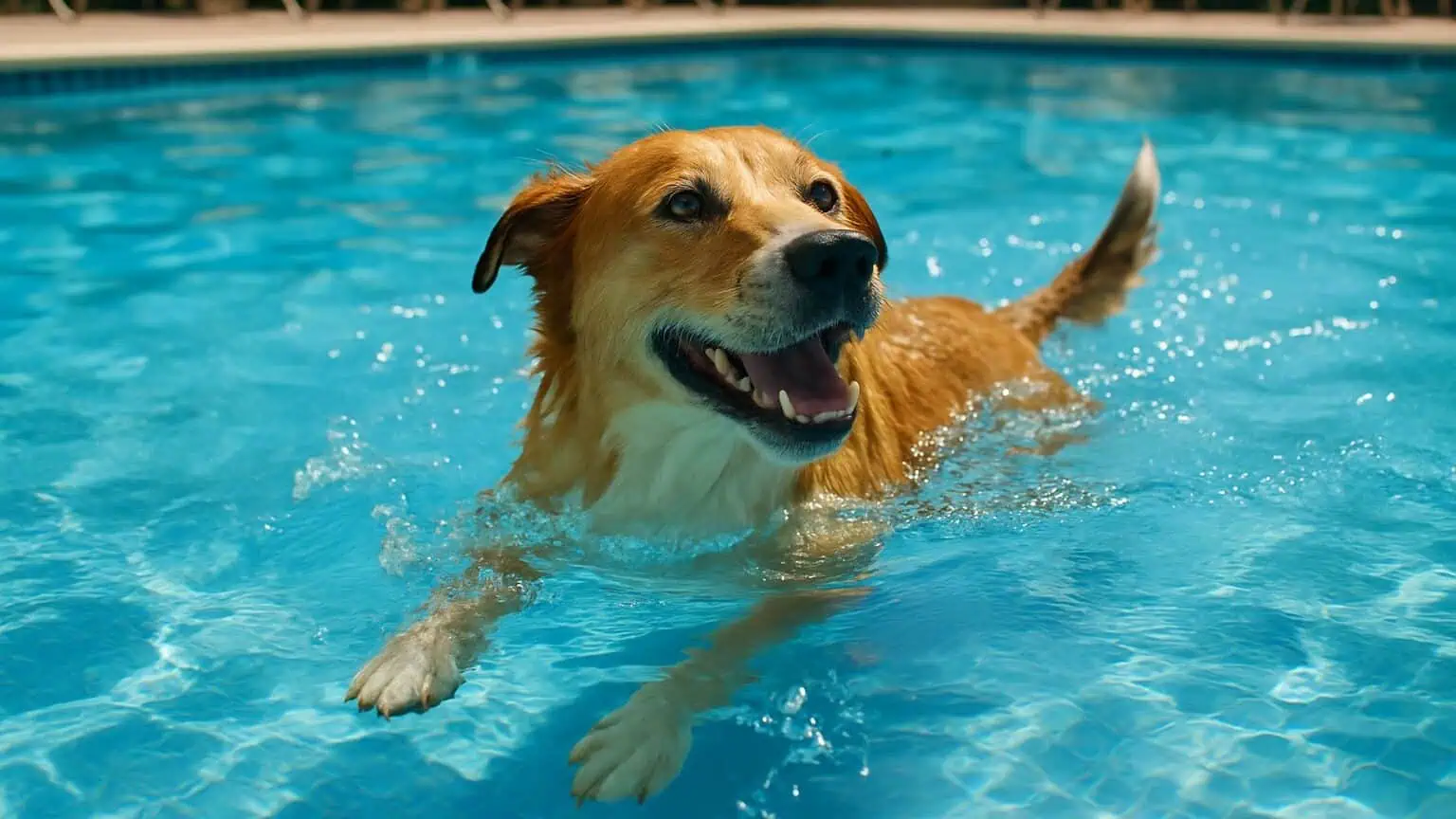
If you understand how chlorine affects dogs, it’s a lot easier to make smart decisions.
Just knowing a few facts can help every swim stay fun and protect your dog’s skin, coat, and eyes. Honestly, once you know what to watch out for, it feels way less stressful to let your dog join in on pool time.
Can Dogs Swim in Chlorine Pools?

Most dogs do fine in a well-kept chlorinated pool. The trick is understanding how chlorine levels can affect them—and how saltwater pools fit into the picture.
Understanding Chlorinated Water
People use chlorinated water in pools to kill germs and bacteria, but the chlorine has to be balanced. When it’s too high, it can irritate a dog’s skin, eyes, or nose. If it’s too low, nasty germs can grow.
Dogs tend to have more sensitive skin than we do. If they swim a lot, the chlorine can dry them out or make them itchy. And while a little pool water probably won’t hurt, dogs shouldn’t be gulping it down—chlorine isn’t safe to drink in big amounts.
After a swim, rinse your dog with fresh water to get rid of chlorine. Keep an eye out for red eyes or scratching. Staying on top of pool maintenance and always supervising your dog helps a lot.
Chlorinated Pools vs. Saltwater Pools
Some people go for saltwater pools. These use salt to make chlorine, but at lower levels than traditional pools. They’re often easier on a dog’s skin and eyes, though chlorine is still there.
Saltwater pools usually don’t have that strong chlorine smell. Some owners say their dogs have fewer skin issues after swimming in them. But if a dog drinks too much saltwater pool water, it can get an upset stomach or even salt poisoning.
No matter which pool you have, you need to test and maintain the water. Rinse your dog off every time, and don’t leave them unsupervised in the pool.
Health Risks of Chlorine Pools for Dogs
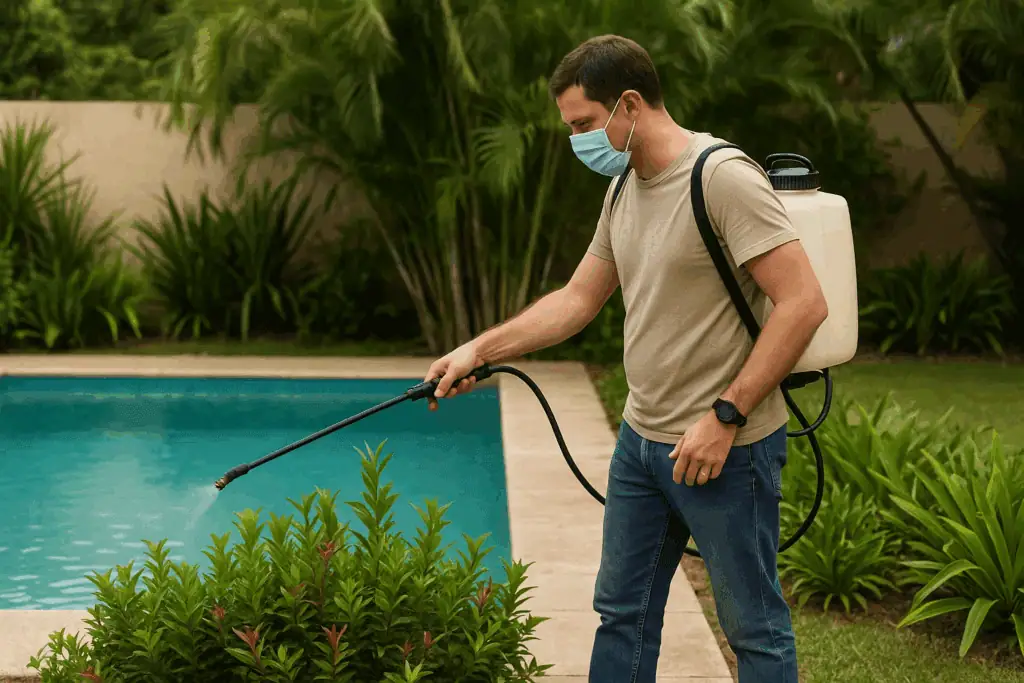
Swimming when there is chlorine in pool water is safe for dogs in most cases, but there are some health risks to keep in mind. The main ones: stomach trouble from drinking pool water and ear infections from water exposure.
Upset Stomach and Diarrhea
Dogs seem to think pool water is a drink sometimes. Even if chlorine levels are low, swallowing pool water can upset a dog’s stomach.
You might see vomiting, upset stomach, or diarrhea—especially if a dog drinks a lot, not just a quick lap. Some dogs are just more sensitive and might react after only a little.
Usually, mild cases clear up with rest and fresh water. But if vomiting or diarrhea sticks around for more than a day, call the vet.
To help, always have fresh water handy by the pool and try to keep your dog from drinking pool water.
Ear Infections
Swimming in pools that use chlorine can set dogs up for ear infections. Water gets trapped in their ear canals, and that warm, damp spot is perfect for bacteria and yeast.
Watch for signs of irritation such as head shaking, ear scratching, or redness. Chlorine can also make sensitive ears even more irritated.
Drying your dog’s ears after swimming really helps. For floppy-eared breeds or frequent swimmers, use a vet-approved ear cleaner sometimes. If your dog seems bothered or there’s a weird smell, pay attention and perhaps visit your veterinary clinic for some professional advice.
Skin and Coat Problems
Potentially, if your dog swims in your chlorine pool frequently, and particularly if they have sensitive skin, then their skin could become itchy and darker furred dogs can become slightly beached.
Chemical Safety and Pool Water Quality
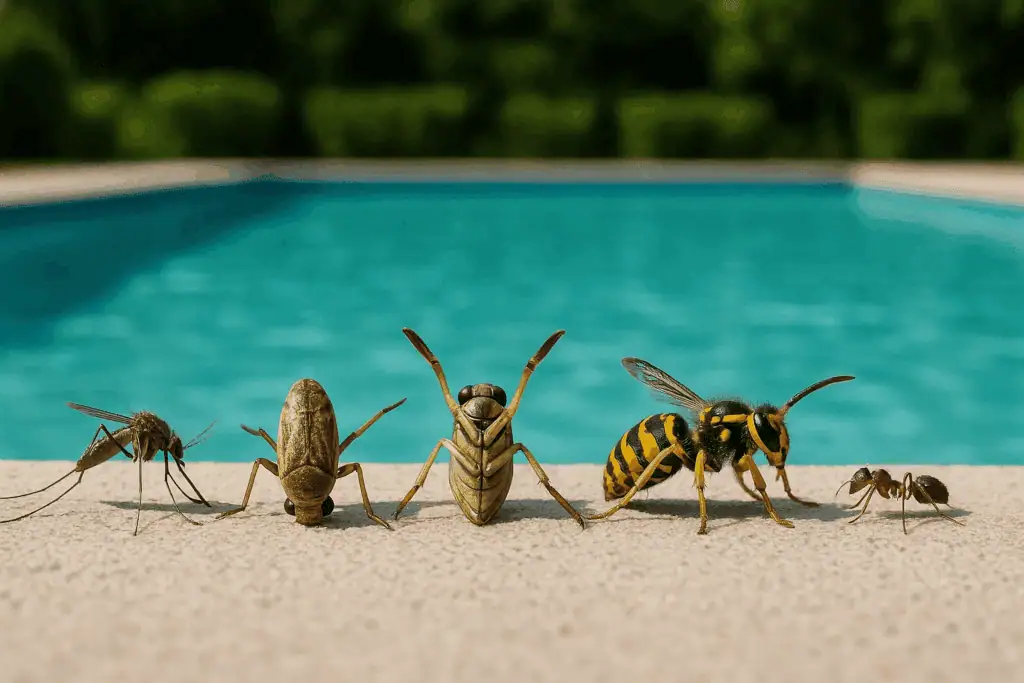
You’ve got to keep an eye on pool water chemistry if your dog’s swimming. Checking chlorine levels, water quality, and how chemicals affect pets goes a long way.
Safe Levels of Chlorine for Dogs
Chlorine keeps pools germ-free, but you want it between 1 to 3 parts per million (ppm)—that’s safe for people and most dogs.
Chlorinated water is safe for most dogs at these levels, even if they swim often, though daily swims could dry out their skin a bit. It’s rare to see serious problems. Still, don’t let your dog drink a lot of pool water—chlorine can make them sick.
If the amount of chlorine climbd above 5 ppm, you might notice red eyes, itchy skin, or a runny nose. Test pool water regularly to keep it in the safe zone.
Impacts of Pool Chemicals on Canine Health
Chlorine isn’t the only thing in pool water. Pools also have algaecides, cleaning agents, and pH stabilizers.
Dogs can be more sensitive to these than people. Some dogs get dry, flaky skin or red, itchy eyes after swimming. Concentrated pool chemicals can be dangerous if a dog drinks them or rolls in freshly treated water.
Watch for:
- Vomiting
- Drooling
- Red eyes
- Coughing or sneezing
If your dog shows these symptoms, rinse them off and call your vet. Always store pool chemicals out of reach and follow the instructions.
Water Chemistry Best Practices
Balanced pool water is safer for everyone. A clean, well-maintained pool means fewer health problems.
Try to:
- Test water weekly for chlorine, pH, and other chemicals
- Keep pH between 7.2 and 7.8
- Clean filters and remove fur—dog hair can really clog things up
- Rinse dogs with clean water after swimming
If you notice redness or irritation, let your dog take a break from the pool. Staying on top of the pool’s chemistry makes summer swimming a lot safer.
Preventing Pool Hazards for Dogs
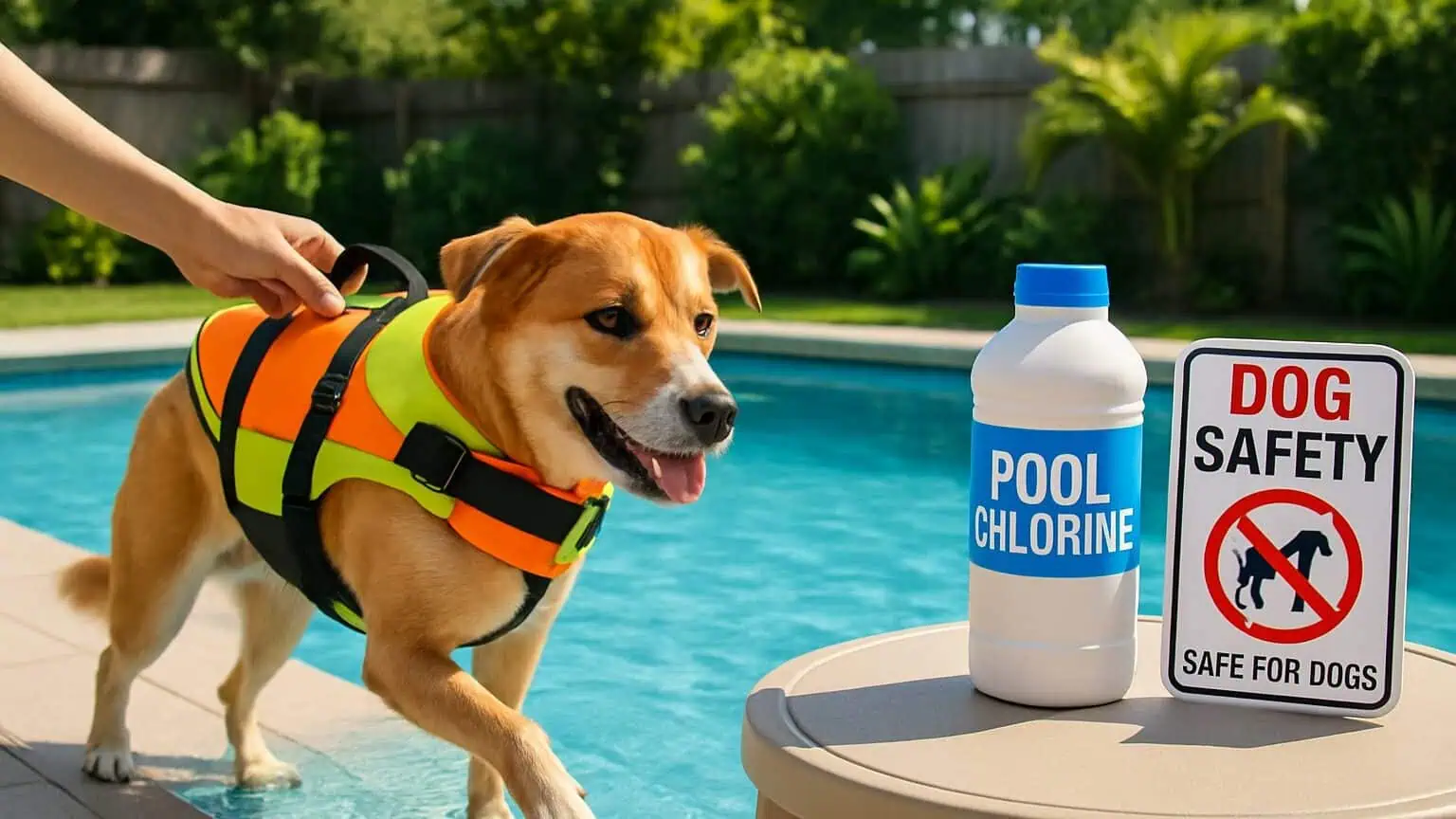
Letting dogs have a swim in a chlorinated pool is usually safe, but a few risks can sneak up on you. Being aware of these makes pool time a lot less stressful.
Risks of Water Intoxication
Water intoxication is rare but scary—it happens when a dog swallows way too much water while swimming or playing in the pool. This drops their blood sodium, which can cause swelling in the brain and organs.
Watch out for:
- Lethargy or weakness
- Vomiting
- Pale gums
- Loss of coordination
Small dogs and toy-fetchers are at higher risk since they tend to gulp water.
To avoid this, don’t let your dog play in the pool for hours on end. Give them breaks and watch how much water they’re swallowing. If you spot symptoms, get your dog out and call your vet.
Fecal Matter and Pool Contamination
Fecal matter in the pool is a big concern when allowing dogs to swim. Even a tiny bit can bring in bacteria like E. coli or parasites such as Giardia.
This isn’t just bad for dogs—people can get sick too. Cloudy water or a strong smell might mean there’s contamination.
To lower the risk:
- Only let healthy, clean dogs in the pool.
- Take bathroom breaks before swimming.
- Clean up accidents fast and use the right pool chemicals to disinfect.
Washing your dog before a swim helps keep bacteria and fur out of the water.
Dog Swimming Safety

Swimming with dogs means you’ve got to think about safety a bit differently. Pool owners should make a few smart choices to keep everyone safe.
Dog Life Vests and Supervision
Most dogs can swim, but a life vest really helps—especially for deeper pools or if your dog isn’t a strong swimmer. Dog life vests keep them afloat and easy to spot, especially if you get a bright color and one with handles.
Always supervise. Never leave kids or dogs alone by the pool. Dogs can tire out or panic if they can’t find the steps. Teach your dog where the exits are.
Before swimming:
- Make sure the vest fits—not too tight, not too loose.
- Check that your dog’s up for swimming.
After swimming:
- Rinse off chlorine so your dog doesn’t get itchy or sick from licking its fur.
Above Ground vs. Inground Pools
Above ground pools have high edges, so dogs might struggle to get out. Add ramps or steps and show your dog how to use them.
Inground pools usually have steps or ledges, but it’s still smart to teach your dog to use them. Barriers or pool fences help prevent accidents when you’re not watching.
Both pool types need a good cleaning after dogs swim—dog hair can clog filters and mess up water quality. Check chlorine levels more often and skim out fur and debris.
Read: Signs Your Dog Is Overheating in the Pool
Maintaining a Dog-Friendly Pool Environment
Keeping your pool safe for dogs takes a bit of effort, clean water, and some attention to details. Staying on top of maintenance keeps pets healthy and the water inviting.
Managing Algae and Cleanliness
Algae can make pool surfaces slippery, boost bacteria, and sometimes bother your dog’s skin or paws. If the water’s cloudy or green, it’s time to clean.
Check chlorine and pH at least weekly. A well-kept swimming pool has clear water and balanced chemicals. Use a skimmer a couple of times a week to grab fur, leaves, and dirt—dogs shed a lot when they swim.
Vacuum the pool and brush the walls weekly to keep algae away. Run your filter daily for at least eight hours. If algae keeps coming back, use a pool-safe algaecide, but don’t let your furry friend swim during treatment.
Quick cleaning tips:
- Scoop out debris and fur after every swim
- Test water quality regularly
- Brush pool walls and floor once a week
Hot Tubs and Other Water Features
Hot tubs really aren’t like pools—they’re way too hot and loaded with more chemicals. That combo can mess with a dog’s skin, sting their eyes, or even make them overheat fast.
Keep those hot tub covers snapped shut when you’re not using them, and try to block off fountains or water features with strong currents. Dogs get curious, sure, but these spots just aren’t for them.
If you’ve got both a pool and a hot tub out back, it’s a good idea to teach your dog to stay out of the hot tub. Maybe put up a barrier or a little gate. For things like waterfalls or fountains that keep water moving, check now and then to make sure the water’s clean and the chemical levels aren’t out of whack.
Important:
- Never let dogs swim in hot tubs
- Cover or block entry to hot tubs and unsafe water features
- Make sure any accessible water is clear and well-maintained




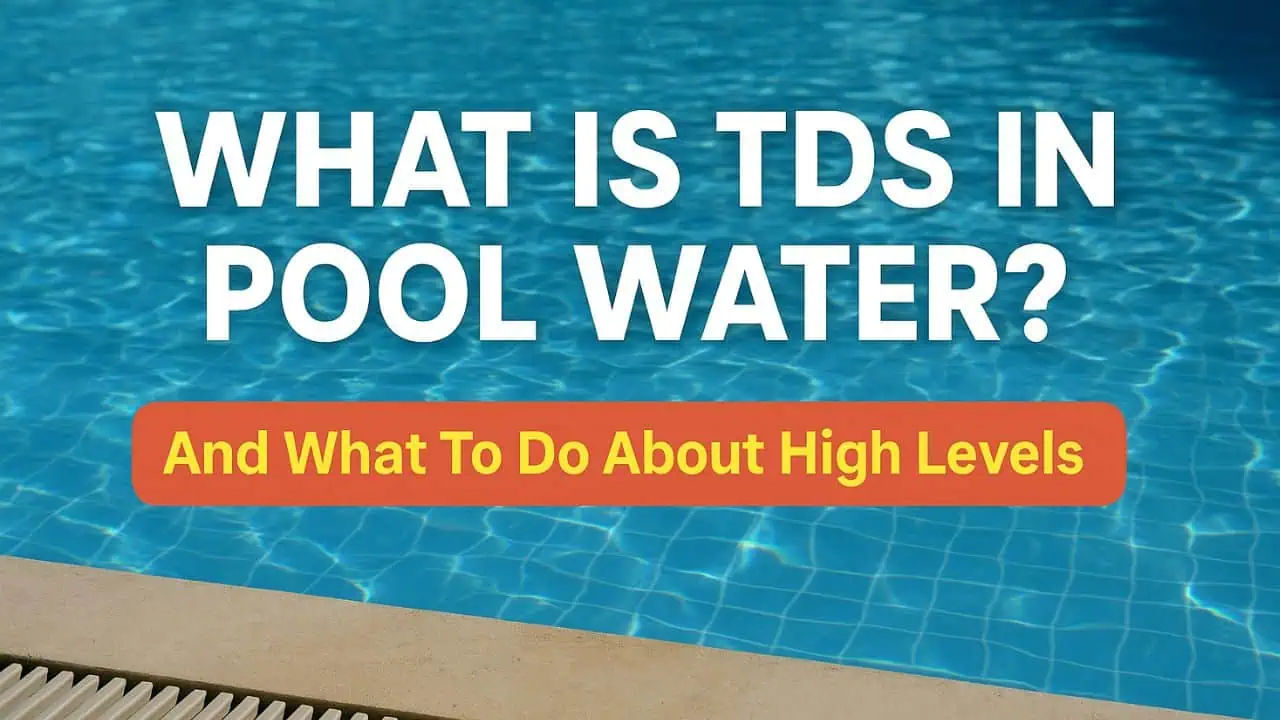
Leave a Reply